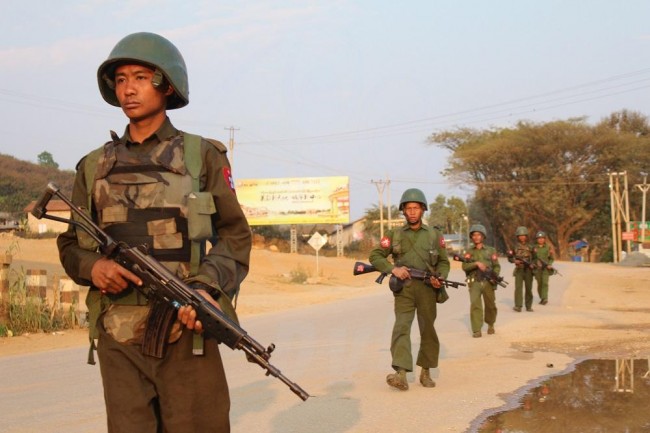The Burmese army has launched a series of attacks on Kokang positions just outside Laogai in recent days using artillery, air strikes and chemical weapons, according to a rebel spokesperson.
Myanmar Nationalities Democratic Alliance Army (MNDAA) spokesman Tun Myat Lin told DVB on Friday that Burmese government forces launched offensives against elevated Kokang positions in the mountains around the districts of Xioalujiang, Xikaolin, Xidonshui and Jixuara, which are all within six to ten kilometers north and northeast of the former Kokang stronghold of Laogai [also spelt Laukkai].
“The Tatmadaw [Burmese army] began shelling our positions with mortars since well before sunrise [on 23 April],” he said. “Then at dawn, using heavy manpower, they attacked us with ground troops. They could not overwhelm our bases, so they retreated and restarted the heavy artillery attacks. This happened several times.
“Among the 1,500 shells they fired at our outposts, about five contained chemicals. The smoke from them was different from other shells: it was bright with a fragrant smell. Our soldiers who inhaled it got nauseous and vomited.”
Tun Myat Lin said the Burmese forces of Light Infantry Division 33 incurred heavy losses in the clashes.
“We lost two men and had 12 injured, but the casualties on the other side were huge,” he said. “We estimate that more than 90 Burmese soldiers were killed, though it could be as high as 140. About 200 were injured.”
DVB could not independently confirm the MNDAA claims. The Burmese government has made no statement about the latest series of battles around Laogai.
The Kokang spokesman said the MNDAA expects an intensification of hostilities as government forces continue to send reinforcements into the area.
On Friday in New York, speaking at a meeting of the Partnership Group on Myanmar, UN Secretary-General Ban Ki-moon made reference to the Kokang conflict in his speech.
“Meanwhile, ongoing clashes in Kachin and northern Shan States have caused immense suffering to civilians,” he said. “The clashes in Kokang are also deeply disturbing in terms of the toll of lives and destruction, as well as their implications for the longer term stability of the region. Humanitarian actors will need unimpeded access to provide much needed aid in a timely fashion. The tensions arising from these clashes must not jeopardize the larger peace process.”
Since fighting broke out in early February, tens of thousands of residents have been displaced, fleeing over the border to China to southwards to the Burmese city of Lashio. Tensions have heightened between Burma and China over the conflict, with Burma offering an apology for the accidental deployment of a bomb over the border on 13 March, which killed five Chinese citizens.
[related]
Until the outbreak of hostilities this year, the Kokang Special Region had enjoyed a period of relative peace. The MNDAA, under the leadership of Peng Jiasheng, enjoyed two decades of ceasefire with the government. This calm faltered in 2009 when armed groups came under pressure to transform into a paramilitary Border Guard Force under the control of the Burmese military.
The MNDAA resisted this move, and tensions with the Burmese military increased, purportedly exacerbated by the MNDAA’s alleged links with the drug trade. Peng Jiasheng was soon ousted in a government-backed coup, and has since lived in exile in China. The Burmese government accuse him of being behind the recent outbreak in fighting.



